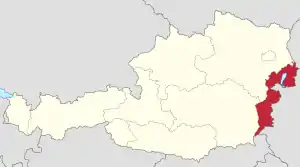Republic of Heinzenland
The Republic of Heinzenland (German: Republik Heinzenland; German pronunciation: [ʁepuˈbliːk 'haɪntsn̩lant]) was a short-lived and unrecognized nation in the region now known as the Austrian federal state of Burgenland, aimed at protecting the German-speaking population in Western Hungary. The state was a direct result of the disputes in Central Europe following the First World War on the future of Burgenland under either Austrian or Hungarian control. Its main leader was Social Democratic politician Hans Suchard. Due to its short life, it is known as the "Two-day Republic".
Republic of Heinzeland Republik Heinzenland Republik Hoanznlaund (local dialect) Hiénc Köztársaság | |||||||||||
|---|---|---|---|---|---|---|---|---|---|---|---|
| 1918–1918 | |||||||||||
 | |||||||||||
| Status | Unrecognized state | ||||||||||
| Capital | Mattersburg | ||||||||||
| Government | Republic | ||||||||||
| Historical era | World War I | ||||||||||
• Established | December 5 1918 | ||||||||||
• Disestablished | December 7 1918 | ||||||||||
| |||||||||||
Etymology
The name "Heinzenland" is derived from the German name for Western Hungary, Heanzenland, Hianzenland, or Hoanzenland[1] (Heinzenland in Standard German).[2] The name "Heanzen" or any variation of it in local dialects referred to German settlers in Western Hungary (west of Sopron), who immigrated from Bavaria and other parts of Germany to Hungary while keeping their own dialects (hence the variation between the names).[3]
There are different theories as to why the Heinzen was used. It may have been used to mock this group of German-speakers for their deviation from the Bavarian hiaz (now), instead using hianz. It might also have been derived from the common name Heinz, or from the followers of Henry II, Duke of Bavaria, Henry I Kőszegi, or Henry IV, Holy Roman Emperor, under whose reigns the settlers came.[4]
The Two-Day Republic
On December 5th, 1918,[5] two weeks after the German-Austrian Provisional National Assembly demanded the self-determination of German-speaking settlements in Western Hungary, Social Democratic politician Hans Suchard, with the help of workers and local Social Democrats in Mattersburg, proclaimed the Republic of Heinzenland. This was done, apparently, without sufficient knowledge of power relations in the region. This might have been done to bring the German-speaking parts of Western Hungary under Austrian control.[6]
However, one day later, the Hungarian military and Sopron vigilantes put an end to the Republic, quickly occupying its territory. Suchard was arrested and sentenced to death. However, the verdict was not enforced and Suchard was not executed.
References
- Wolfram Dornik, „Das war wie im Wilden Westen“. Folgen von Grenzverschiebungen als Folge des Ersten Weltkrieges.... In: Siegfried Mattl u. a. (Hrsg.): Krieg, Erinnerung, Geschichtswissenschaft, Veröffentlichungen des Clusters Geschichtswissenschaft der Ludwig Boltzmann Gesellschaft Bd. 1, S. 73–87, Böhlau, Wien 2009, S. 74, ISBN 978-3-205-78193-6
- Das Heinzenland. In: Oststeirerblatt. Wochenschrift zur Wahrung der wirtschaftlichen Interessen der Oststeiermark und Deutsch-Westungarns I, Nr. 8 (2. November 1919), S. 1 nach Wolfram Dornik, „Das war wie im Wilden Westen“, S. 74
- "Das Heanzenland. 3sat, Reihe Stadtland". 3sat.de. Retrieved 11 November 2019.Hans Ferdinand Helmolt: Weltgeschichte. Band Südosteuropa und Osteuropa. (= Band 5 Weltgeschichte), Bibliographisches Institut, Leipzig 1905, S. 390
- Heanzen in Austria-Forum (in German) (at AEIOU); Hugo Kastner: Von Aachen bis Zypern. Geografische Namen und ihre Herkunft. Anekdoten, Fakten und Vergleiche. Mehr als 3500 Namen aus aller Welt. Humboldt, Baden-Baden 2007, ISBN 978-3-89994-124-1, S. 68.
- Hans Suchard (21 November 1929). "Eine Republik, die 12 Stunden alt wurde".
- August Ernst: Geschichte des Burgenlandes, R. Oldenbourg Verlag Munich, 1991. ISBN 3702803114.
Further reading
- August Ernst: Geschichte des Burgenlandes, R. Oldenbourg Verlag München, 1991. ISBN 3702803114.
- Gerald Schlag: Aus Trümmern geboren – Burgenland 1918–1921 (= Wissenschaftliche Arbeiten aus dem Burgenland. Band 106). Burgenländisches Landesmuseum, Eisenstadt 2001, ISBN 3-85405-144-1, Seite 136ff. (Online)